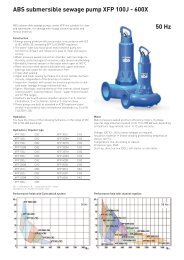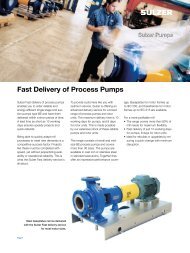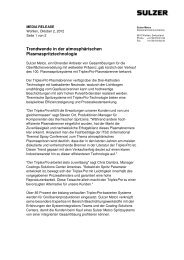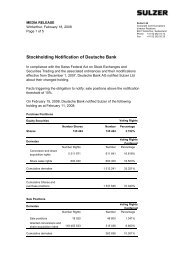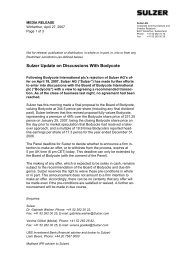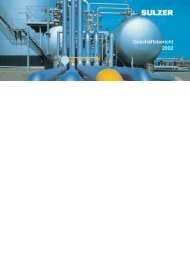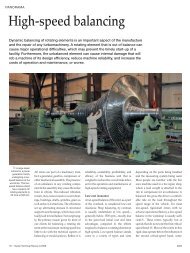Testing and quality
Testing and quality
Testing and quality
Create successful ePaper yourself
Turn your PDF publications into a flip-book with our unique Google optimized e-Paper software.
provides a database, which, by reviewing<br />
vibration trends, is helpful in predicting<br />
mechanical problems in rotating<br />
machines <strong>and</strong> estimating future maintenance<br />
needs, extending the duration<br />
between inspections, <strong>and</strong> minimizing<br />
downtime for maintenance.<br />
Vibration or displacement sensors are<br />
mounted on or as close as possible to<br />
the bearings at the drive <strong>and</strong> non-drive<br />
ends of the machine. Vibration measurements<br />
will be recorded radially—at two<br />
points 90° apart at each end—<strong>and</strong><br />
axially—generally at the drive end. The<br />
sensors signals can be reviewed as a<br />
waveform or processed using fast<br />
Fourier transformations <strong>and</strong> displayed<br />
as a frequency spectrum for detailed<br />
analysis. Trend analysis is used to<br />
identify change in condition <strong>and</strong> to<br />
predict failure.<br />
Case study Gillette<br />
Vibration analysis was carried out on<br />
a four-pole induction motor driving a<br />
48-inch conveyor belt in a surface<br />
coalmine preparation plant. Figures 1<br />
<strong>and</strong> 2 illustrate the correlation of the<br />
vibration data to the actual damage on<br />
the rotor of a 1000HP (750 kW) induction<br />
motor. The amplitude of the harmonics<br />
<strong>and</strong> amount of side b<strong>and</strong>ing at rotor slip<br />
frequency are indicators of severity of<br />
the problem.<br />
Note: These side b<strong>and</strong>s, with differential<br />
frequency of 0.67 Hz from the fundamental,<br />
can be used to calculate the<br />
rotor slip of this four-pole motor at the<br />
rotation speed indicated in the data plot.<br />
The height of the side b<strong>and</strong>s, together<br />
with an increase of the slip frequency,<br />
gives an indication of the severity of<br />
damage to the cage rotor winding.<br />
Figure 3 clearly confirms the fault<br />
condition identified in the vibration<br />
analysis as a failure of the rotor cage<br />
winding with several broken rotor bars.<br />
Vibration analysis has also been successful<br />
at determining bearing defects associated<br />
with variable frequency drives<br />
(VFDs). VFDs are notorious for causing<br />
fluting damage (EDM, electrical discharge<br />
machining) in antifriction bearings if the<br />
rotor shaft is not grounded properly.<br />
These defects have been detected by<br />
the reliability groups at several of our<br />
customers’ plants.<br />
The following example is of a 350HP<br />
(4160 volt) four-pole induction motor<br />
driving a conveyor in a surface coal mine<br />
prep plant.<br />
The vibration data in the trend display<br />
<strong>and</strong> high frequency spectrums indicated<br />
a defect that had become so significant<br />
that corrective action was recommended<br />
to the customer 4.<br />
The bearings, which had been removed<br />
from the motor, clearly showed evidence<br />
of electrical discharge machining 5.<br />
They were replaced <strong>and</strong> a commercially<br />
available shaft current diverter ring was<br />
installed in the motor to discharge the<br />
eddy currents developed on the rotor.<br />
These changes should prevent recurrence<br />
of this motor failure.<br />
PD analysis <strong>and</strong> further tests<br />
When high partial discharge (PD)<br />
activity is detected during online testing,<br />
equipment users usually want to verify<br />
the problem by performing a visual<br />
inspection <strong>and</strong>/or doing some off-line<br />
testing before taking the machine out of<br />
service. The traditional off-line tests are<br />
the direct current (DC) insulation resistance<br />
(IR), polarization index (PI), <strong>and</strong><br />
alternating current (AC) tan delta tests<br />
(called Tip Up Test in North America),<br />
off-line PD test <strong>and</strong> close visual inspection.<br />
All these tests are well understood<br />
<strong>and</strong> have been employed for many<br />
years.<br />
The main limitation of off-line insulation<br />
tests is the requirement for a<br />
machine outage, which, in some cases,<br />
may take several days. In addition,<br />
during off-line tests, winding insulation<br />
is not subjected to operating stresses<br />
experienced in service, <strong>and</strong>, therefore, it<br />
does not truly reflect the condition of<br />
the insulation system in service. Online<br />
testing provides more accurate <strong>and</strong> more<br />
reliable diagnostic information regarding<br />
the insulation condition whilst in service.<br />
Online PD monitors can detect PD<br />
activity, a significant increase of which<br />
is an indication of potential insulation<br />
degradation; this increase can, over time,<br />
lead to insulation failure for large<br />
machines above 5000V.<br />
PK (in/s)<br />
RMS Acc. (G-s)<br />
Acc. (G-s)<br />
1.6<br />
1.2<br />
0.8<br />
0.4<br />
0<br />
1.6<br />
1.2<br />
0.8<br />
0.4<br />
0<br />
10<br />
5<br />
0<br />
–5<br />
–10<br />
–15<br />
Measurement principle<br />
Partial discharge (PD) activity, in rotating<br />
electrical machines, is the physical breakdown<br />
of a gas, usually air, within a void,<br />
in a gap, or adjacent to solid insulation<br />
within an insulation system in the<br />
presence of high electrical stress. This<br />
discharge can cause chemical <strong>and</strong><br />
thermal degradation in the materials<br />
adjacent to the discharge. As Pd activity<br />
continues, highly conductive materials<br />
are formed from the epoxy resin binders<br />
or other materials. As the carbon atoms<br />
contained in the insulating materials<br />
become free molecules, they join together<br />
<strong>and</strong> form carbon tracks. If this Pd<br />
activity continues, it will cause permanent<br />
damage to the insulation system <strong>and</strong><br />
eventually will cause a complete breakdown<br />
or failure of the insulation system.<br />
This breakdown of the gas results in<br />
an electrical spark, which generates a<br />
high-frequency signal that can be moni -<br />
tored by a variety of methods: though<br />
a directly connected capacitor, indirectly<br />
using a Rogowski coil, through a radio<br />
frequency receiver, by employing an<br />
TESTING AND QUALITY<br />
0 400 800 1200 1600<br />
Days<br />
0 1000 2000 3000 4000 5000<br />
Frequency (Hz)<br />
0 0.5 1.0 1.5 2.0 2.5 3.0 3.5 4.0<br />
4 Conveyor drive motor trend display, frequency spectrum,<br />
<strong>and</strong> waveform.<br />
Revolution number<br />
5 Photo of the bearing<br />
damage detected by<br />
the vibration data in<br />
figure 4.<br />
Sulzer Technical Review 1/2011 | 23



